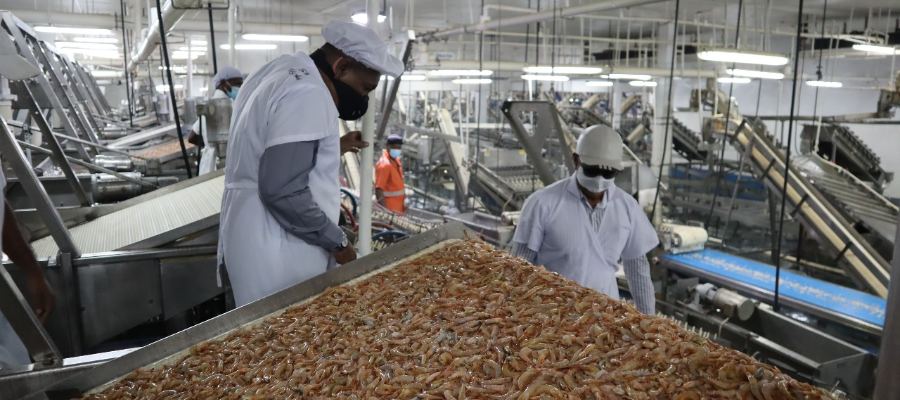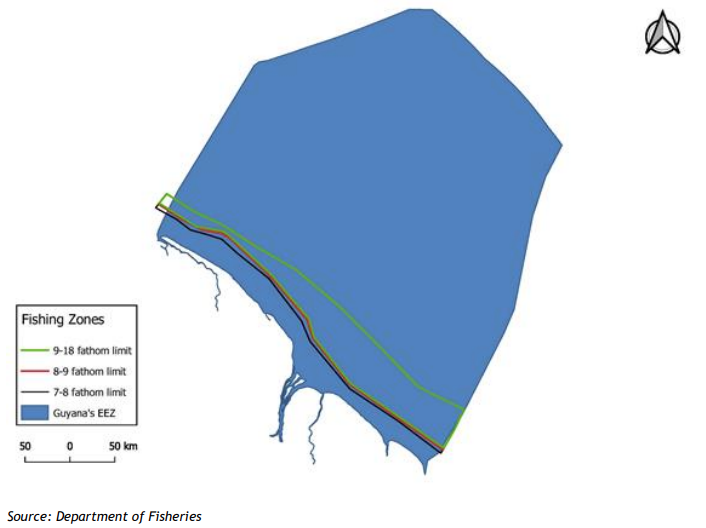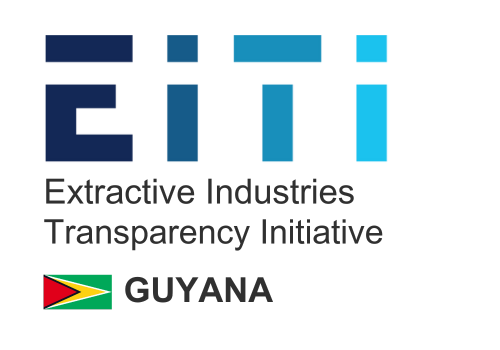
Overview
Guyana lies on the North coast of the South American sub-continent with 432 km coastline long and 48,665 km2 continental shelf. The corresponding Exclusive Economic Zone (EEZ) area is 138,240 km2 . The fisheries sector contributed 1.5% towards the total GDP in 201995 and it is of critical importance to both the economy and to social well-being of the country. Guyana produced over 38 thousand metric tons of marine products during 2019 as detailed in Section 3.12.4 of this report. The fisheries sector has three main components, namely: marine fishery, inland fishery and aquaculture.
Marine Fishery
Marine fishery in Guyana includes industrial trawl fishery, deep slope fishery (semi-industrial red snapper fishery), and small-scale artisanal fishery: – the industrial trawl fisheries are based mainly in the Demerara River.97 This sub-division includes mainly sea bob trawlers, prawn trawlers and finfish trawlers.98 – deep slope fisheries or semi-industrial red snapper fishery consists of fishing by vessels that use traps or longlines to fish at depths of between 120 m and the edge of the continental shelf; and – small-scale or artisanal fishery supplies in both rural and urban areas. This sub-division of the marine fisheries sector includes over 5,000 artisanal fishers and comprises a thousand vessels ranging from 6 to 18 meters in size, and which are propelled by sails, outboard or inboard engines. Most boat owners are members of cooperative societies which acquire and sell fishing requisites to their members. The Fishermen’s Co-operative Society was formed 50 years ago and contributed to the development of the fisheries sector. It also played an important role in the mobilisation of artisanal fishermen, in education, capacity building and in the maintenance and management of fish landing sites.99 According to the Department of Fisheries (DoF), the artisanal fishery is an open fishery and can fish in any part of Guyana’s EEZ as presented below:

Inland Fisheries
This sub-sector includes subsistence fishery for local consumption as well as ornamental fish for export. Most inland fishing is carried out by Indigenous people out of rivers, lakes, creeks, canals and flood plains in savannah areas. To date, there is no functioning Inland Fisheries Policy. The Food and Agricultural Organisation (FAO) supported the Guyana Fisheries Department (Ministry of Agriculture), with the drafting of an Inland Fisheries Policy and associated Strategic Plan. After in-depth consultations, the documents were finalised in 2013. However, the policy and plan have yet to be adopted and implemented. Growing pressures for action on inland fisheries has prompted the Fisheries Department to have the documents reviewed. FAO is again providing financial and technical support for the review of the documents. The review was carried out in late 2020 and the final report was to be submitted to the contracting parties. The review of the draft report indicated that the draft policy was still fairly sound and could be approved with some tweaking. The associate strategic plan would, however, need some work as the landscape for some of the proposed actions had changed. Recommendations were also made as to the organisational structure for management of the fisheries resources: these included providing financial resources and appointing fisheries officers to the remote regions. There was also a call for regulations to be drafted.
The Arapaima Management Plan focuses on the Rupununi River, a key habitat for the Arapaima, a CITES endangered species (arapaima gigas). This was a tri-partite plan designed and implemented by the Government of Guyana – Department of Fisheries, the Iwokrama Centre and the North Rupununi District Development Board. It is also recommended that this plan is reviewed and updated.
Institutional Framework
The Fisheries sector is managed by the Fisheries Department (FD) of the Ministry of Agriculture. The Ministry is headed by the Minister of Agriculture and administrated by a Permanent Secretary, who are advised by the Chief Fisheries Officer and by a Fisheries Advisory Committee (FAC). The FAC comprises fishing industry and ministry personnel and also considers matters sent to it by the Minister. FD is responsible for the management, regulation and promotion of the exploitation and development of Guyana’s fisheries resources for the benefit of the participations in the sector and the national economy. The department’s authority was originally defined in the Fisheries Act 1957 and redefined by the Fisheries Act 2002.
The image below shows the current organization structure of the Fisheries Department:

The Maritime Administration Department (MARAD) was created under the Shipping Act (1998). Its main
responsibilities include:
• registering and licensing of ships;
• implementing and enforcing maritime codes, conventions and practices;
• prevention of accidents;
• surveying of ships on port to ensure safety practices are upheld;
• assist in search and rescue operations;
• prevention of pollution on ships; and
• ensure ports comply with security regulations.
The Veterinary Public Health Unit, which is also part of the Ministry of Health is the “Competent Authority” that was set up to enforce Regulation No 7 of 2003, (the Fisheries Products Regulations) under the Fisheries Act 2002. These regulations deal with all aspects of quality control, inspection, and certification of plant and animal products.
The Stakeholder Organisations include the Guyana Association of Trawler Owners and Seafood Processors (GATOSP), the Guyana Marine Conservation Society (GMCS) and thirteen fishers cooperative societies. The sector does not have a unified organization.
The Guyana Water Authority (GWA) was created under the Guyana Water Authority Act (1972). It is responsible for controlling and regulating the collection, production, treatment, storage, transmission and use of water
Legal Framework
The following are the main legislations which govern the fisheries sector:
The Fisheries Act (2002)
This act was created to cater for the promotion, management and development of the fisheries sector and all ancillary matters. It covers the registration of fishing vessels,
provides for the inspection of vessels, the issuance of a license number, display on fishing boats, etc, as well as changes in ownership, amendments to the register. In addition to
registration of vessels, the Act covers the licensing of individual fishermen and for fish export licenses;
The Maritime Zones Act (2010)
this act repealed the Marine Boundaries Act (1977) that first set up a fisheries zone beyond and adjacent to territorial waters (i.e. beyond 12 n.mi) and extending out to 200 n.mi. from land. In 1991, the zone became recognised as an EEZ
| The Guyana Shipping Act (1998)2 | The Fisheries Regulations | The Fisheries (Aquatic WildLife Control) Regulations | The Fisheries (Pin Seine) Regulations |
|---|---|---|---|
| The Guyana Shipping Act (1998) provides for licensing of ships and safety requirements. | The Fisheries Regulations (Reg. 13/1957, 1/1959, 31/1969, 20/1970, 5/1993) provide for the registration of fishing boats, fishing licenses, erection of fish pens, as well as license fees. | The Fisheries (Aquatic WildLife Control) Regulations (1966) provide conditions to capture, collect, remove, or slaughter any form of prescribed aquatic wildlife found in any waters in the country. | The Fisheries (Pin Seine) Regulations (1962) specify the features and conditions for handling pine seine and fish. |
| The Fisheries Products Regulations (2021) | The Fisheries (Turtle Excluder Device) Regulations (2006) | The Fisheries (Exemption from Registration and Licensing) Order (2018) | The Fisheries Regulations (No.3 of 2018)3 |
|---|---|---|---|
| The Fisheries Products Regulations (2021) provide conditions for exporting and marketing of fisheries products. | The Fisheries (Turtle Excluder Device) Regulations (2006) provide the requirements for the protection of sea turtles. | The Fisheries (Exemption from Registration and Licensing) Order (2018) revokes the 1957 fishing regulations and exempts local fishing vessels not exceeding five meters in length from specific provisions. | The Fisheries Regulations (No.3 of 2018) provides for the registration of foreign fishing vessels, local fishing vessels, high seas fishing, fishing gear, equipment, and devices, along with license fees. It includes provisions on the protection of turtles, vessel monitoring systems, controlled areas, and training. |
| Fisheries (Amendment) Regulations (Reg. 04/2022) | The Marine Mammal Protection Regulation 2022 | Wildlife Conservation Act 2016 |
|---|---|---|
| Fisheries (Amendment) Regulations (Reg. 04/2021) revises the licence/permit fees, reducing all licence/permit fees. | The Marine Mammal Protection Regulation 2021 prevents marine mammal species and population stocks from declining beyond significant functioning elements of the ecosystems they are part of. | Wildlife Conservation Act 2016 provides for the protection, conservation, management, sustainable use, internal, and external trade of wildlife. |
In 2020, the Fisheries Department (FD) worked with the Food and Agriculture Organization of the United
Nations (FAO) to develop regulations for aquaculture and inland fisheries regulations.149 The proposed
revision provided a definition of aquaculture, regulated the licensing procedure for engaging in and
establishing an aquaculture facility, and contained substantive provisions on enforcement, violations, and
penalties.

